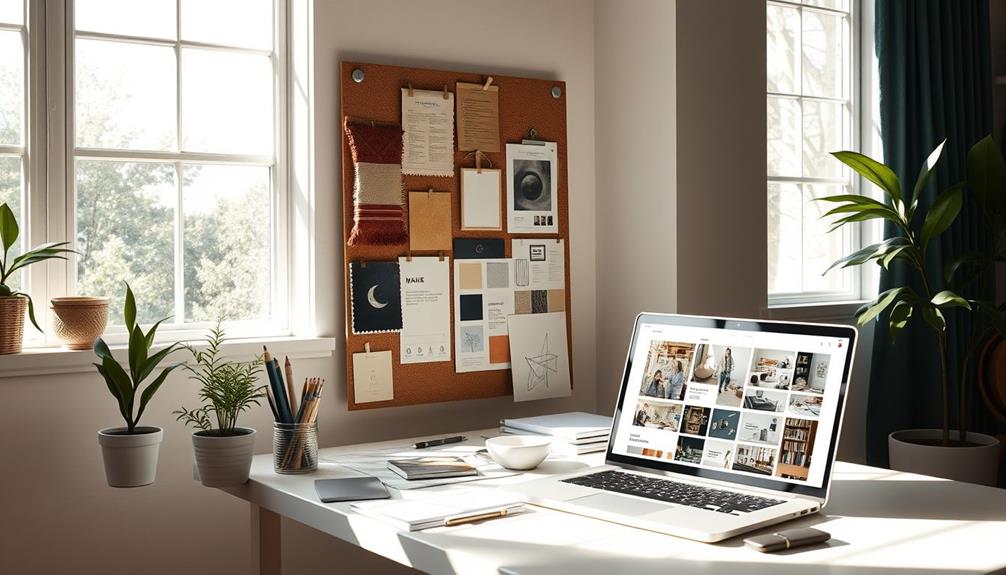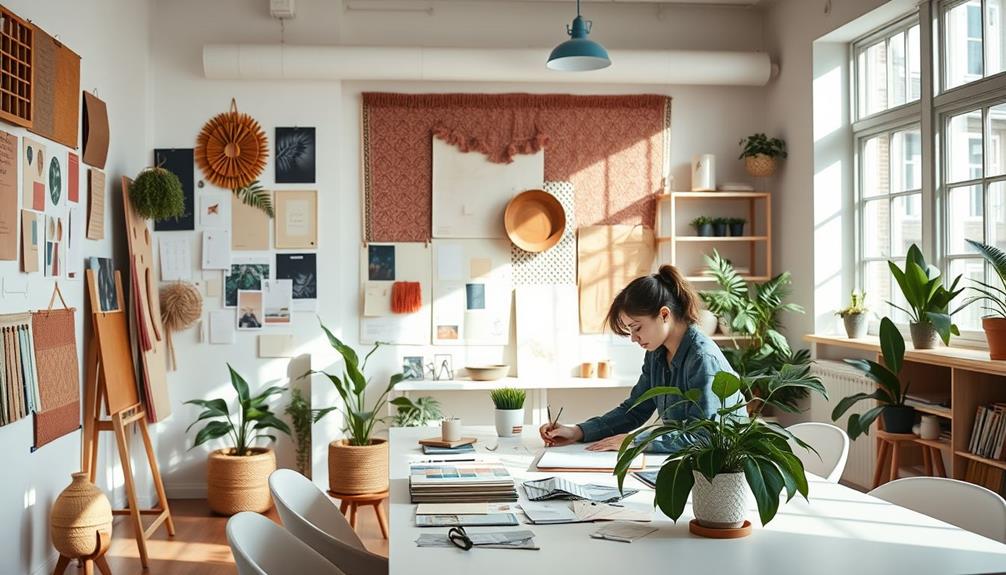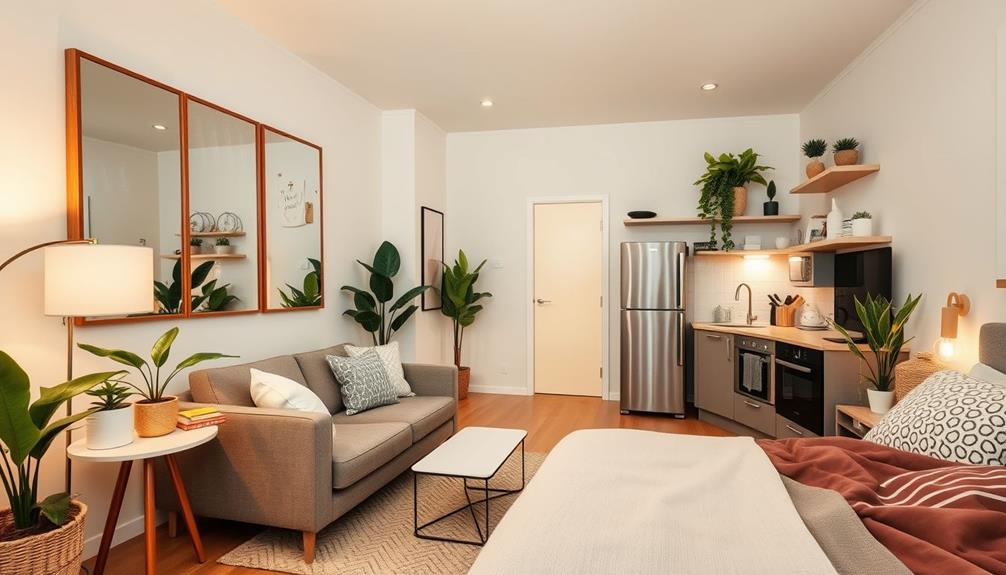You can break into interior design without experience by following a few key steps. Start by exploring online courses or certificate programs to learn the basics. Build a portfolio showcasing your work, even if it's personal projects or volunteering. Gain hands-on experience through internships or volunteering with local organizations. Networking is essential, so connect with industry professionals through events or social media. Tailor your resume to highlight transferable skills and apply for entry-level positions like design assistants. With these strategies, you'll develop a solid foundation for your new career, and there's much more to discover ahead. To enhance your portfolio, consider creating a professional website to showcase your work and attract potential clients. Including before-and-after photos, mood boards, and design sketches in your portfolio can demonstrate your creativity and attention to detail. Utilize social media to share your projects and connect with potential clients, and seek feedback from mentors or peers to continually improve your portfolio. These interior design portfolio tips can help you stand out in a competitive industry and demonstrate your potential as a designer.
Key Takeaways
- Pursue certificate programs or online courses to gain foundational knowledge in interior design principles and software tools.
- Build a diverse portfolio by documenting personal projects, volunteer work, and informal designs to showcase your creativity.
- Seek internships or volunteer opportunities with established designers to gain practical experience and insights into the design process.
- Network actively by attending industry events, engaging in conversations, and utilizing social media to connect with professionals in the field.
- Apply for entry-level positions, such as design assistants, to acquire hands-on experience and leverage transferable skills from previous roles.
Educational Pathways and Training
Starting a career in interior design requires a solid educational foundation. You can choose from various educational pathways, like pursuing a 2-year or 4-year degree in Interior Design or a related field. These programs equip you with essential knowledge and skills that are critical for entering the industry.
If you're looking for a quicker option, consider certificate programs that focus solely on decorating. They enhance your qualifications without the commitment of a full degree.
Online courses and workshops also provide flexibility and targeted training on specific design principles and software tools. For more hands-on experience, participating in design boot camps can be invaluable. These intensive programs allow you to gain practical skills needed for real-world application in interior design projects.
Additionally, obtaining certifications, such as NCIDQ or LEED, can greatly enhance your credibility and marketability in the competitive job market.
Building a Portfolio

Once you've laid a solid educational foundation, the next step in your interior design journey is building a compelling portfolio. Start by creating a diverse collection that features a mix of personal projects, volunteer work, and informal design tasks you've completed for friends or family. This showcases your unique style and creativity.
Document your design process by including sketches, mood boards, and before-and-after photos. This will provide a thorough view of your design thinking and execution.
Consider offering free or discounted design services to local nonprofits or community projects. It's a great way to gain practical experience while generating portfolio pieces that reflect real-world applications.
Utilize digital platforms to create an online professional portfolio, ensuring it's easily accessible for potential clients or employers. Regularly update it with your latest work to keep it fresh.
Finally, seek feedback from experienced designers or mentors. Their insights can enhance your portfolio's quality and presentation, helping you align with industry standards.
A well-rounded portfolio won't only demonstrate your skills but also greatly boost your chances of landing your first design opportunity.
Gaining Practical Experience

Gaining practical experience is essential for anyone looking to break into the interior design field. One of the best ways to start is by seeking internships or apprenticeships with established designers or firms. These opportunities often provide hands-on experience and valuable training that can help you grasp the nuances of the industry.
Additionally, exploring island getaways can inspire your design perspective by exposing you to unique cultural elements and aesthetics that can be incorporated into your work.
You can also volunteer for local design projects or community organizations. This not only helps you gain practical experience but also allows you to build a portfolio showcasing your work. Assisting friends or family with their design needs, even on a small scale, can further develop your skills while creating a collection of projects.
Participating in design competitions or community events is another excellent way to apply your creativity in real-world scenarios. You'll gain exposure to the industry while honing your abilities.
Additionally, consider shadowing experienced designers during their projects. This offers insights into the design process, client interactions, and industry best practices.
Networking Strategies

In the competitive world of interior design, effective networking can be your ticket to valuable opportunities and connections. Start by announcing your presence to family and friends; they can refer you to prospective clients or alert you to openings at interior design firms.
Establish a professional website and active social media accounts to showcase your design interests and projects. This enhances your visibility and attracts networking opportunities.
Don't hesitate to reach out to industry professionals for informational interviews. These conversations can provide valuable insights and may lead to job leads.
Attend industry trade shows and local design events to meet professionals, learn about current trends, and expand your network with potential mentors and collaborators.
When engaging in conversations, demonstrate confidence and be specific about your interests and goals. This approach can greatly improve your networking strategies, leading to more meaningful connections.
Remember that networking is a two-way street, so be prepared to offer your assistance or insights in return. By building genuine relationships, you'll not only grow your network but also position yourself favorably in the competitive interior design landscape.
Job Search Techniques

Finding the right job in interior design requires a strategic approach tailored to your unique skills and experiences. Start by utilizing job boards specific to the interior design industry, like InteriorDesignJobs.com and Archinect. These platforms often list entry-level positions and internships ideal for beginners.
To boost your chances, consider these techniques:
- Tailor your resume and cover letter to highlight transferable skills, even if they come from unrelated fields.
- Leverage connections made through networking events, design associations, and social media platforms like LinkedIn to uncover job leads.
- Apply for volunteer positions or internships with local design firms or nonprofits to gain practical experience and build your portfolio.
- Stay persistent and open to various roles; entry-level positions such as design assistants can provide invaluable hands-on experience.
Conclusion
Breaking into interior design without experience might feel like stepping into an uncharted room, but with the right preparation, you can transform that space into a masterpiece. By pursuing education, building a strong portfolio, and networking effectively, you'll lay the foundation for your future career. Keep seeking practical experiences, and don't shy away from opportunities. With perseverance and creativity, you'll soon find yourself not just in the room, but at the center of it all.








